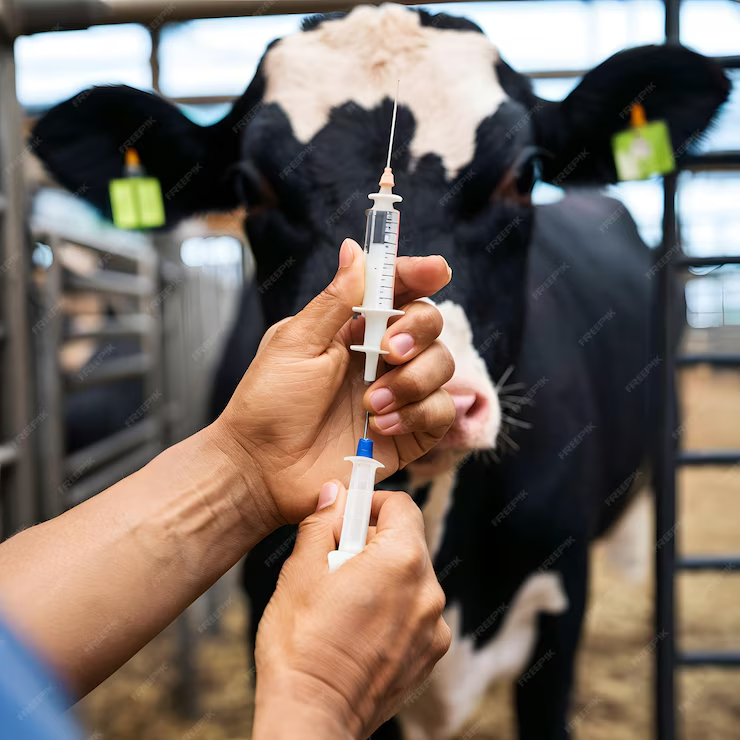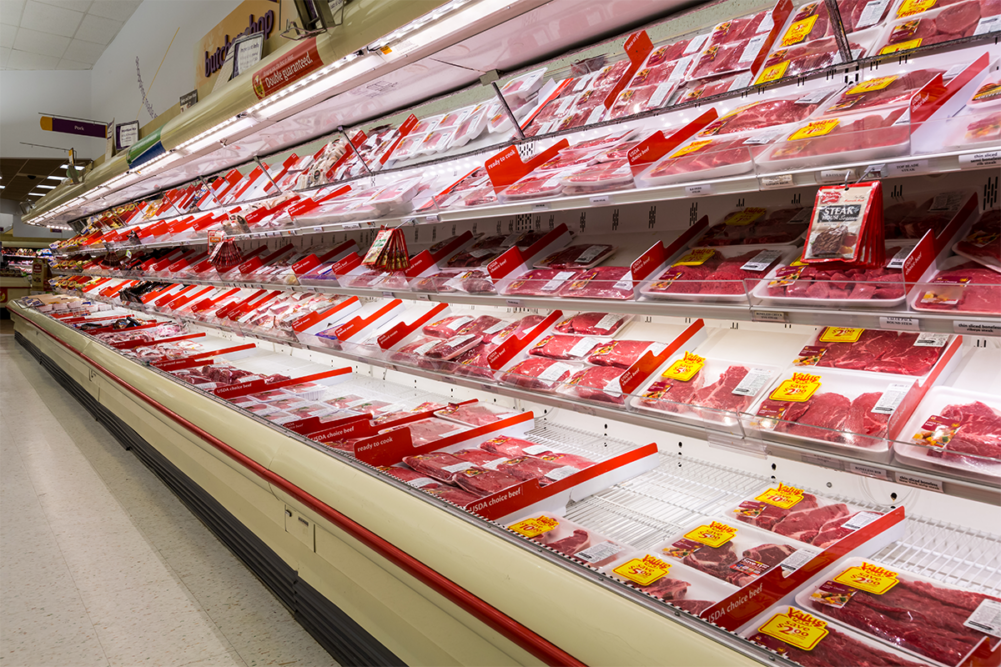
Credit: Muhammad Shoaib
How Did We Get Here?
The industrial and agricultural revolutions increased economic growth exponentially. These cultural phenomena gave birth to a population explosion which, in turn, fostered the demand for an expanding and organized workforce.
In the late nineteenth and early twentieth centuries, immigrants poured into the United States seeking jobs and a new life. Many came from agrarian cultures and found themselves concentrated in cities, crammed in unsafe dwellings, and working in noisy, toxic factories ten to twelve hours a day and without land, resources, or time to grow their own food. Large-scale industrial farms, stockyards, and slaughterhouses—also referred to as confinement operations—expanded and developed into the country’s main source of food supply. The balanced symbiotic relationship that farmers and herders once had with animals for millennia quickly began to erode and morph into an outdated and forgotten notion relegated to animal rights activists now considered to be extremists.
Over the years, as animal confinement operations expanded and intensified, new production practices inadvertently resulted in a rapid decline in animal health. Cows, pigs, and poultry were locked in buildings away from fresh air, space, and natural light. In cramped cages, diseases were easily transmissible, paving the way for antibiotics and vaccines as a means to mitigate this human-caused crisis.
Antibiotics In the Livestock Industry
The use of antibiotics in the livestock industry is a religion. Instead of administering antibiotics as needed, animals with no particular sickness are routinely fed antibiotics in fear of decreased production levels and profits. A study produced by The National Center for Biotechnology Information (NCBI) reports:
Global consumption of antimicrobials in food animal production was estimated at 63,151 (±1,560) tons in 2010 and is projected to rise by 67%, to 105,596 (±3,605) tons, by 2030. Two thirds (66%) of the global increase (67%) in antimicrobial consumption is due to the growing number of animals raised for food production. The remaining third (34%) is imputable to a shift in farming practices, with a larger proportion of animals projected to be raised in intensive farming systems by 2030.
In 2010, the five countries with the largest shares of global antimicrobial consumption in food animal production were China (23%), the United States (13%), Brazil (9%), India (3%), and Germany (3%). By 2030, this ranking is projected to be China (30%), the United States (10%), Brazil (8%), India (4%), and Mexico (2%).
What Could Possibly Go Wrong?
The use of antibiotics that inadvertently make their way into the bloodstreams of both animals and people who consume animal products is steadily increasing the risk of antibiotic resistance. This triggered an outcry and a concentrated effort to limit antibiotics in the food chain.
Common sense—a one-time rational and friendly proposal offered by openminded adults, now a politically charged catchphrase—would suggest that decentralizing animal production and putting animals in a healthier environment would greatly reduce, if not totally eliminate, the need for antibiotics. Unfortunately, this idea is not feasible in a market-driven economy that commodifies food and food production. Instead, we are full speed ahead and seeking new and more efficient ways to poison animals and the people that consume them.
Enter mRNA Vaccines Stage Left and Right
Hailed as “safe and effective” by the Biden and Trump administrations, messenger RNA (mRNA) vaccine technology—the untested and unsafe technology that has killed and injured millions of people worldwide—has already been given the green light for swine by the United States Department of Agriculture (USDA).
At the 2018 World Pork Expo, Merck Animal Health introduced Sequivity, a swine vaccine platform developed by Merck in partnership with Moderna.
As described on Merck’s Animal Health website:
A revolutionary swine vaccine platform, SEQUIVITY harnesses RNA particle technology to create customized prescription vaccines against strains of influenza A virus in swine, porcine circovirus (PCV), rotavirus and beyond. It’s supported by a sophisticated dashboard filled with comprehensive data and insights …
Five years later at the 2023 World Pork Expo, Dr. Brett O’Brien, a technical services veterinarian with Merck Animal Health, was not just excited, but was “super excited” to introduce Merck’s new Circumvent CML vaccine for swine:
We’re super excited to be launching our first of its kind vaccine, Circumvent CML. It is a three-in-one vaccine that controls for diseases Porcine Circovirus Type 2a (PCV-2a), Porcine Circovirus Type 2d (PCV-2d), Mycoplasma hyopneumoniae, and Lawsonia intracellularis. The new vaccine is built on Merck’s foundation of tried-and-true proven antigens and adjuvant systems that have been available in Circumvent PCV-M G2 and their stand-alone product Porcilis Ileitis. But now the extra convenience in one bottle.
The Receipts—Oink! Oink!
In a 2024 interview with the Real Business Owners Podcast, fifth-generation boots-on-the-ground cattle rancher Braden Jensen recounted a troubling study involving 500 pigs given mRNA vaccines. He said that the USDA came out with a study on pigs because pigs were the first to be trialed with the mRNA vaccines. Within a couple of weeks, about 100 pigs died—they got so sick they stopped eating, with symptoms like severe diarrhea and dehydration. When the meat was tested later, they still found traces of the vaccine.
The Race Is On!
The H5 bird flu fear fest that resulted in the senseless culling of thousands of chickens and sent egg prices through the roof, now has US cattle in the crosshairs. It appears that a new version of the bird flu identified as D1.1 has emerged and is reportedly threatening livestock and the country’s supply of meat and dairy products.
Messenger RNA Vaccines to the Rescue
The push to pass legislation allowing the untested use of mRNA technology and its long-term effects on human health is rapidly gaining momentum in the USA. In a 2024press release, the National Association of State Departments of Agriculture’s (NASDA) CEO Ted McKinney said:
NASDA prioritizes the well-being of livestock and public health, and we must ensure farmers and ranchers have access to approved mRNA vaccines to ensure the health of their animals and provide a safe and resilient food supply.
What Are the Risks?
It seems inconceivable and utterly irresponsible, but the use of mRNA vaccines that have killed and disabled millions of people around the world is being considered for use on cattle and has been on the drawing board for a number of years. While meat producers and vaccine manufacturers are salivating at the prospect of exploiting a new market, the troubling question remains: Can genetic injections given to animals affect the person who consumes the animal product?
A study published by Chinese scientists details the testing of mRNA-laced milk injected into the intestines of mice. The RDB mRNA was successfully absorbed through the digestive tract and became active in their bodies. The researchers plan to follow up with a version where the mice are fed the mRNA rather than being injected and promise a more efficient means of compromising one’s immune system in their paper’s conclusion:
SARS-CoV-2 RBDmRNA vaccine loading via bovine-milk-derived exosomes is an easy, cheap, and novel way to introduce immunity against SARS-CoV-2 in vivo. In the near future, an mRNA delivery system based on milk-derived exosomes will serve as a platform for mRNA therapeutics development [Emphasis added].
Hold the Phone!
Opponents to the use of mRNA in cattle say that, similar to the presence of mRNA in vaccinated pigs, injecting mRNA vaccines into cattle would yield the same outcome, exposing consumers of meat, milk, and other dairy products to toxic proteins and lipid nanoparticles without their knowledge of potential health risks or their informed consent.
In September 2024, the United States Cattleman’s Association (USCA) released the following policy statement regarding mRNA technologies:
… the U.S. Cattlemen’s Association opposes the use of Ribonucleic Acid (RNA) Gene Therapy Platform Technology inoculations, e.g., messenger RNA (mRNA), modified RNA (modRNA), self-replicating RNA (sRNA), and self-amplifying RNA (saRNA) with or without misnomer vaccine, in meat- or milk-producing animals, until scientifically sound raw data is available for open review by researchers with no conflicts of interest and publicly available research studies are published and peer-reviewed on the short- and long-term health, safety and fertility effects in mRNA, modRNA, sRNA and saRNA inoculated animals and humans consuming the resulting meat or milk products.
The USCA also voiced concerns about consumer protection noting:
Consumers deserve to know how their food is produced. USCA will continue to prioritize the safety and transparency of the beef supply chain and advocate for the health and wellbeing of its consumers, as it always has.
The USCA Policy Resolution 5 states:
Animal Health (Renewed 2022) WHEREAS U.S. cattle producers are held to high animal health and food safety inspection standards, making U.S. beef products sought after by consumers around the world; and WHEREAS other countries utilize products such as certain beta agonists and antibiotics which are illegal for use in the US in food producing animals; THEREFORE, BE IT RESOLVED the United States should not accept meat products from countries who allow drugs or beta agonists that are not legal for use in the U.S. [Emphasis added].
Sounds great! However, while the USCA remains cautious about the use of mRNA vaccines in livestock, other countries exporting meat to the United States, like Australia and Canada, don’t share the same concerns.
New South Wales (NSW) regulatory authorities are brimming with confidence and are ready to authorize the use of mRNA vaccine technology on Australian livestock in the event of an outbreak of lumpy skin disease (LSD) and foot-and-mouth disease (FMD). The NSW Government website clearly states:
Developing sovereign local capacity to produce vaccines against emergency animal diseases is a critical priority for Australian agricultural industries and the economy.
Australian Pesticides and Veterinary Medicines Authority (APVMA), have very strict standards to demonstrate that the vaccine is safe for animals, that there is no safety risk to people who are using these vaccines nor to people who consume animal products from treated livestock [Emphasis added].
As part of the NSW Government’s $96 million biosecurity project, they are partnering with Tiba, a Boston-based biotech firm. In 2024, Tiba announced:
The NSW Government is continuing to invest in and prioritize the biosecurity of NSW, with a cutting-edge emergency animal disease vaccine reaching a major milestone. The NSW Government pilot project to fast-track an mRNA vaccine for border disease virus (BDV) has been successfully manufactured for the first time in NSW [Emphasis added]. This is one element of the NSW Government’s comprehensive plan to boost biosecurity across NSW.
———————————————————————————————————————
Note to Self: One can never be prepared enough. Even the NSW Government knows that shit happens. Dropping a cool $96 million of taxpayer money on a biosecurity project for development of an mRNA vaccine that has yet to be approved takes balls, foresight, and creativity—not to mention a crystal ball predicting a sudden outbreak of bovine lumpy skin and foot-and-mouth diseases in the very near future.
———————————————————————————————————————
Canadian beef industry regulators are pretty much on board with their Aussie counterparts. They haven’t yet officially approved mRNA vaccines for Canadian beef, but that may soon change. The Canadian Cattlemen reported:
. . . mRNA vaccines are being tested for viral diseases such as foot-and-mouth disease and lumpy skin disease (primarily found in warm, tropical climates).
There are specific situations in which mRNA vaccines may provide an invaluable tool in protecting the health of the Canadian cattle herd. For example, if foot-and-mouth disease ever reappeared in Canada, an mRNA vaccine could be an effective tool to rapidly contain and eradicate it.
Mandatory Country-of-Origin Labeling (MCOOL)

Credit: Source: ©mandritoiu – stock.adobe.com
Ask most American meat consumers where their beef is coming from, and you will more than likely get a shrug of the shoulders. Hit them with some stats and they might be shocked to learn that the United States imports meat products from thirty-one countries with thirty-one different regulatory policies for raising, feeding, injecting, and slaughtering livestock.
Import totals released by the United States Department of Agriculture (USDA) indicates that Australia and Canada are the two largest sources of meat products imported to the United States. As of March 14, 2025 YTD, Australian imported meat products totaled 108,017 metric tons, a 19% increase from 2024 YTD total of 90,840. In this same time period, imported Canadian meat products totaled 142,329 metric tons, an 11% decrease from Canada’s 2024 total of 171,448 metric tons.
American consumers of beef and pork may be even more shocked to learn that—despite all the safety and regulatory jargon—the USDA does NOT have their backs.
At present, beef and pork are the only two products imported into the United States of America that do not require a mandatory country-of-origin label, an industry-wide acronym referred to as “MCOOL.” Mandatory COOL had been previously established but was repealed in 2016 by the US Agricultural Marketing Service that ruled in favor of the removal of MCOOL requirements for beef and pork muscle cuts, ground beef, and ground pork. This sudden reversal in legislation was ushered in after the World Trade Organization (WTO) ruled that American MCOOL requirements violated its trade agreements by unfairly discriminating against Canadian and Mexican livestock producers.
What Does This Mean for Consumers?
It means that when meat products enter the US from unregulated countries, they are mixed in with similar US meat products and then processed, packaged, and distributed throughout the country with a USDA stamp of approval. It also means that you would have better than a 99.9% chance of winning your state lottery twice in one year than being able to track down the exact origin of your recently purchased pork loin or New York strip steak that may have slipped under the radar and hit the American shores from God knows where.
With pushback from foreign meat exporters and import/export middlemen, bipartisan legislation is in the congressional pipeline to enact the passage of the American Beef Labeling Act that would require Mandatory Country of Origin Labeling (MCOOL), promising more transparency for American consumers. While the bill introduced in the US Senate seeks to require beef sold in the United States to display its country of origin, this may be of little consequence to consumers concerned about the use of mRNA vaccines in livestock.
Demand Action
The tide is rapidly changing along with growing awareness of the inherent dangers of toxic, gene-based vaccines.
During a hearing before the Montana House Judiciary Committee, Dr. Christine Drivdahl-Smith, a family physician and volunteer board member for the Montana Medical Freedom Alliance, testified as an expert witness. In her opening statement, Dr. Drivdahl-Smith emphatically stated:
Gene-based vaccines, or MRNA vaccines, are the most destructive and lethal medical products that have ever been used in human history. I’m asking you to support this bill banning gene-based vaccines so that we can halt continued harm, disability, and death of our citizens.
What Can We Do as Citizens?
If we already know that human breast milk was contaminated with trace amounts of the mRNA vaccine after Covid-19 injections, consumers of beef, pork, and other animal products should contact RFK Jr.—our McDonald’s Big Whopper eating Make America Healthy Again man in the White House—and demand that he insist that the USDA, the Food And Drug Administration (FDA), and the Center for Disease Control (CDC) put mRNA livestock vaccines on indefinite hold pending an extensive independent review of mRNA cross contamination from cows and other animals to humans and their long-term effects, the results of which should be made publicly available at every venue where meat and dairy products are sold.
We can also contact our state legislators and demand that they immediately enact legislation banning the use of gene-based vaccines on humans, animals, and plants.
